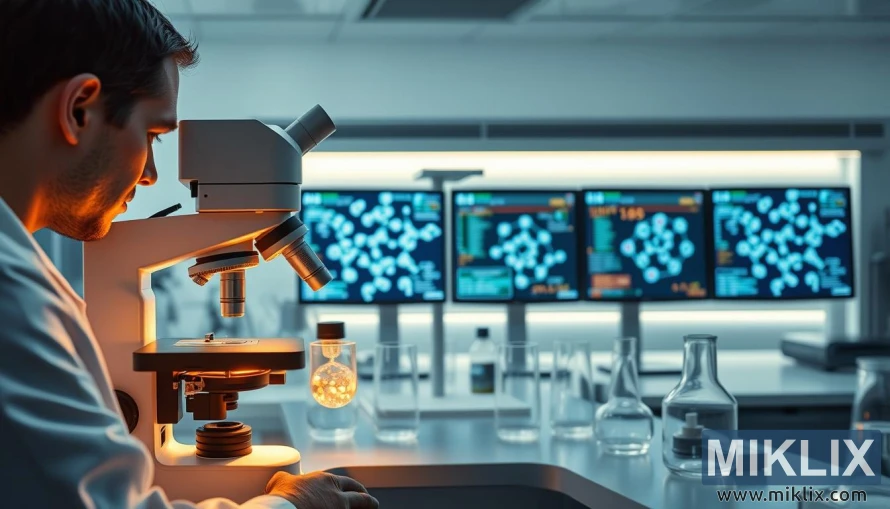Image: Hyaluronic Acid Lab Research
Published: June 30, 2025 at 1:56:52 PM UTC
Last updated: September 26, 2025 at 4:45:47 PM UTC
In a modern lab, a researcher studies hyaluronic acid under a microscope with data screens and advanced equipment in the background.
The laboratory depicted in the image exudes an atmosphere of modernity, precision, and quiet determination, where advanced technology and human intellect converge in the pursuit of discovery. At the forefront, a researcher clad in a pristine white lab coat leans attentively over a high-powered microscope, their concentration evident in the way they position themselves close to the illuminated eyepiece. The warm glow from the instrument’s light source falls across their focused expression, contrasting against the cool, clinical tones of the surrounding environment. On the workbench nearby, an assortment of carefully arranged glassware—flasks, beakers, and vials—catch the subtle reflections of the laboratory lights, emphasizing both the sterile environment and the meticulous organization that defines scientific practice. A transparent container filled with a faintly luminous solution sits just beneath the microscope, a likely sample of hyaluronic acid, its delicate shimmer suggesting the potential for groundbreaking insights hidden at the molecular level.
Extending beyond the researcher’s station, the middle ground of the laboratory reveals a bank of sleek computer monitors, their screens alive with detailed visualizations of molecular structures and streams of analytical data. The digital renderings, intricate and constantly shifting, mirror the microscopic worlds being observed at the workstation, bridging the gap between tangible experimentation and computational analysis. Together, these tools underscore the dual reliance of modern science on both hands-on observation and advanced data modeling. Each flicker of light across the displays hints at complex algorithms processing vast amounts of information, converting raw data into meaningful insights that could one day shape new treatments, technologies, or materials.
The backdrop of the room continues this sense of harmony between functionality and aesthetic refinement. Clean architectural lines, polished surfaces, and brushed metal accents lend the space an air of minimalist elegance, reinforcing its role as a place where clarity and precision are paramount. The subdued, carefully designed lighting is soft and diffused, avoiding harsh shadows while maintaining a focused environment that encourages deep concentration. The interplay of warm and cool tones—amber hues from the microscope blending with the cooler blues and greys of the screens and surroundings—creates a visual rhythm that mirrors the balance between human intuition and technological advancement.
Together, these elements evoke more than just the image of a laboratory; they capture the essence of scientific pursuit itself. It is a place where dedication and patience meet cutting-edge innovation, where every sample under the lens could contain answers to pressing questions or open pathways to entirely new fields of understanding. The quiet intensity of the researcher, the hum of the machines, the glow of molecular models displayed on the monitors—all coalesce into a tableau of progress and possibility. This environment embodies the tireless curiosity that drives humanity to peer ever deeper into the unseen, unraveling mysteries at the most fundamental levels in the hope of shaping a better future.
The image is related to: Hydrate, Heal, Glow: Unlocking the Benefits of Hyaluronic Acid Supplements

